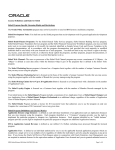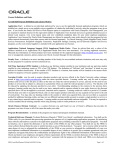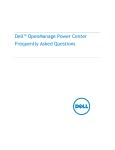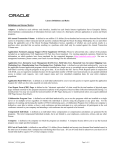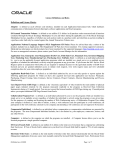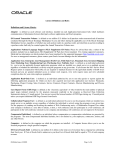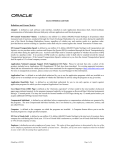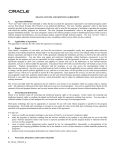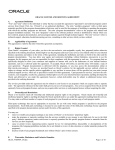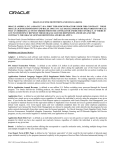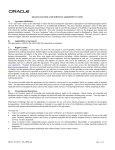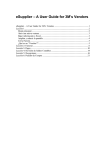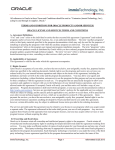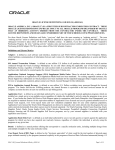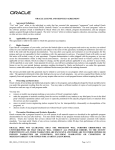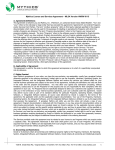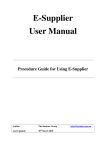Download License Definitions and Rules
Transcript
License Definitions and Rules
E-Business Suite Program Definitions and License Metrics
$M Annual Transaction Volume: is defined as one million U.S. dollars in all purchase orders transacted and all auctions
conducted through the Oracle Exchange Marketplace by you and others during the applicable year of the Oracle Exchange
Marketplace license, regardless of whether any such auction results in a purchase order, provided that an auction resulting in a
purchase order shall only be counted against the Annual Transaction Volume once.
Applications National Language Support (NLS) Supplement Media Packs: Please be advised that only a subset of the
products included on an Applications NLS Supplement Media Pack have been translated. For existing supported customers,
MetaLink has information on which products have been translated for the supported languages (http://metalink.oracle.com). For
new or unsupported customers, please contact your Oracle Account Manager for this information.
Application User: is defined as an individual authorized by you to use the applicable licensed application programs which are
installed on a single server or on multiple servers regardless of whether the individual is actively using the programs at any given
time. If you license the Oracle Self Service Work Request option in conjunction with Oracle Enterprise Asset Management, you
are required to maintain licenses for the equivalent number of Application Users licensed and you are granted unlimited access to
initiate work requests, view work request status and view scheduled completion dates for your entire employee population.
Application Users licensed for Oracle Order Management are allowed to manually enter orders directly into the programs but any
orders entered electronically from other sources must be licensed separately. For Oracle Sourcing, Oracle iSupplier Portal, and
Oracle Services Procurement, PeopleSoft eSupplier Connection, PeopleSoft Strategic Sourcing and JD Edwards Supplier Self
Service programs, use by your external suppliers is included with your application user licenses.
Application Read-Only User: is defined as an individual authorized by you to run only queries or reports against the application
program for which you have also acquired non read-only licenses, regardless of whether the individual is actively using the
programs at any given time.
Compensated Individual: is defined as an individual whose compensation or compensation calculations are generated by the
programs. The term Compensated Individual includes, but is not limited to, your employees, contractors, retirees, and any other
Person.
Computer: is defined as the computer on which the programs are installed. A Computer license allows you to use the licensed
program on a single specified computer.
$M Cost of Goods Sold: is defined as one million U.S. dollars in the total cost of inventory that a company has sold during their
fiscal year. If Cost of Goods Sold is unknown to you then Cost of Goods Sold shall be equal to 75% of total company revenue.
Customer: is defined as the customer entity specified on the ordering document. The programs may not be used or accessed for
the business operations of any third party, including but not limited to your customers, partners, or your affiliates. There is no
limitation on the number of computers on which such programs may be copied, installed and used.
Electronic Order Line: is defined as the total number of distinct order lines entered electronically into the Oracle Order
Management application from any source (not manually entered by licensed Order Management Users, Professional Users 2003,
or Professional Users 2003 - External) during a 12 month period. This includes order lines originating as external EDI/XML
transactions and/or sourced from other Oracle and non-Oracle applications. You may not exceed the licensed number of order
lines during any 12 month period.
Employee: is defined as all of your full-time, part-time, temporary employees and all of your agents, contractors and consultants.
The quantity of the licenses required is determined by the number of Employees and not the actual number of users. In addition,
you elect to outsource any business function(s) to another company, all of the company’s full-time, part-time, temporary
employees and agents, contractors and consultants that are providing the outsourcing services for you must be counted for the
purposes of determining the number of Employees.
OPN.EBS.Partner.OLSAdef.v062309.USA.doc
Page 1 of 10
Expense Report: is defined as the total number of expense reports processed by Internet Expenses during a 12 month period.
You may not exceed the licensed number of expense reports during any 12 month period.
Field Technician: is defined as an engineer, technician, representative, or other person who is dispatched by you, including the
dispatchers, to the field using the programs.
$M Freight Under Management: is defined as one million US Dollars of the total transportation value of tendered orders for all
shipments for a given calendar year during the term of the license. FUM shall include the combined total of actual freight
purchased by you, plus the cost of freight for shipments managed by you (e.g., you are not purchasing transportation services on
behalf of your clients but are providing transportation management services for your clients). Freight that is paid by a third party
shall also be included in the FUM total (e.g., inbound shipments from suppliers to you with freight terms of prepaid).
Full Time Equivalent (FTE) Student: is defined as any full-time student enrolled in your institution and any part-time student
enrolled in your institution counts as 25% of an FTE Student. The definition of "full-time" and "part-time" is based on your
policies for student classification. If the number of FTE Students is a fraction, that number will be rounded to the nearest whole
number for purposes of license quantity requirements.
Hosted Named User: is defined as an individual authorized by you to access the hosted service, regardless of whether the
individual is actively accessing the hosted service at any given time.
1K Invoice Line: is defined as one thousand invoice line items processed by the program during a 12 month period. You may
not exceed the licensed number of Invoice Lines during any 12 month period unless you acquire additional Invoice Line licenses
from Oracle.
Learning Credits: may be used to acquire education products and services offered in the Oracle University online catalogue
posted at http://www.oracle.com/education under the terms specified therein. Learning credits may only be used to acquire
products and services at the list price in effect at the time you order the relevant product or service, and may not be used for any
product or service that is subject to a discount or a promotion when you order the relevant product or service. The list price will
be reduced by applying the discount specified in your order. Notwithstanding anything to the contrary in the previous three
sentences, learning credits may also be used to pay taxes, materials and/or expenses related to your order; however, the discount
specified above will not be applied to such taxes, materials and/or expenses. Learning credits are valid for a period of 12 months
from the date your order is accepted by Oracle, and you must acquire products and must use any acquired services prior to the end
of such period. You may only use learning credits in the country in which you acquired them, may not use them as a payment
method for additional learning credits, and may not use different learning credits accounts to acquire a single product or service or
to pay related taxes, materials and/or expenses. Learning credits are non-transferable and non-assignable. You may be required to
execute standard Oracle ordering materials when using learning credits to order products or services.
$M in Managed Assets: is defined as one million U.S. dollars of the following total: (1) Book value of investment in capital
leases, direct financing leases and other finance leases, including residuals, whether owned or managed for others, active on the
program, plus (2) Book value of assets on operating leases, whether owned or managed for others, active on the program, plus (3)
Book value of loans, notes, conditional sales contracts and other receivables, owned or managed for others, active on the program,
plus (4) Book value of non earning assets, owned or managed for others, which were previously leased and active on the program,
including assets from term terminated leases and repossessed assets, plus (5) Original cost of assets underlying leases and loans,
originated and active on the program, then sold within the previous 12 months.
Module: is defined as each production database running the programs.
Monitored User: is defined as an individual who is monitored by an Analytics program which is installed on a single server or
multiple servers, regardless of whether the individual is actively being monitored at any given time. Individual users who are
licensed for an Analytics program by either Named User Plus or Application User may not be licensed by Monitored User. For
the purposes of the Usage Accelerator Analytics program, every user of your licensed CRM Sales application program must be
licensed. For the purposes of the Human Resources Compensation Analytics program, all of your employees must be licensed.
For the purpose of the following Oracle Governance, Risk, and Compliance applications: Application Access Controls Governor,
Application Access Controls for E-Business Suite, Configuration Controls Governor, Configuration Controls for E-Business
Suite, Transaction Controls Governor, Preventive Controls Governor, and Governance, Risk, and Compliance Controls Suite, the
number of Monitored Users is equal to the total number of unique E-Business Suite users (individuals) being monitored by the
OPN.EBS.Partner.OLSAdef.v062309.USA.doc
Page 2 of 10
program(s), as created/defined in the User Administration function of E-Business Suite. Users of iProcurement and/or SelfService Human Resources are excluded.
For the purpose of the following PeopleSoft Enterprise Governance, Risk, and Compliance applications: Application Access
Controls Governor, Application Access Controls for PeopleSoft Enterprise, Configuration Controls Governor, and Configuration
Controls for PeopleSoft Enterprise, the number of Monitored Users is equal to the total number of unique PeopleSoft Enterprise
(or any other custom applications / programs) users (individuals) that the program monitors.
Named User Plus / Named User: is defined as an individual authorized by you to use the programs which are installed on a
single server or multiple servers, regardless of whether the individual is actively using the programs at any given time. e. All of
the remaining provisions of this definition apply only with respect to Named User Plus licenses, and not to Named User licenses.
A non human operated device will be counted as a named user plus in addition to all individuals authorized to use the programs, if
such devices can access the programs. If multiplexing hardware or software (e.g., a TP monitor or a web server product) is used,
this number must be measured at the multiplexing front end. Automated batching of data from computer to computer is permitted.
You are responsible for ensuring that the named user plus per processor minimums are maintained for the programs contained in
the user minimum table in the licensing rules section; the minimums table provides for the minimum number of named users plus
required and all actual users must be licensed.
For the purposes of the following programs: Configuration Management Pack for Applications, System Monitoring Plug-in for
Hosts, System Monitoring Plug-in for Non Oracle Databases, System Monitoring Plug-in for Non Oracle Middleware, Diagnostics
Pack for Non-Oracle Middleware, Management Pack for WebCenter Suite, Management Pack for IBM Websphere Portal and
Provisioning Pack, only the users of the program that is being managed/monitored are counted for the purpose of determining the
number of Named User Plus licenses required.
For the purposes of the following programs: Application Management Pack for Oracle E-Business Suite, Application Change
Management Pack for Oracle E-Business Suite, Application Management Pack for Siebel, and Application Management Pack for
PeopleSoft Enterprise, all users of the middleware and/or database software that support the respective application program are
counted for the purpose of determining the number of Named User Plus licenses required.
With respect to the following programs: Load Testing for Web Applications, Load Testing for Web Applications Developer
Edition, Load Testing Accelerator for Web Services, and Load Testing Accelerator for Siebel, each emulated human user and non
human operated device shall be considered as a virtual user and shall be counted when determining the number of Named User
Plus licenses required.
Oracle Finance Division Contract: is a contract between you and Oracle (or one of Oracle’s affiliates) that provides for
payments over time of some or all of the sums due under your order.
Partner Organization: is defined as an external third party business entity that provides value-added services in developing,
marketing and selling your products. Depending upon the type of industry, partner organizations play different roles and are
recognized by different names such as reseller, distributor, agent, dealer or broker.
Person: is defined as your employee or contractor who is actively working on behalf of your organization or a former employee
who has one or more benefit plans managed by the system or continues to be paid through the system. For Project Resource
Management, a person is defined as an individual who is scheduled on a project. The total number of licenses needed is to be
based on the peak number of part-time and full-time people whose records are recorded in the system.
Ported Number: is defined as the telephone number that end users retain as they change from one service provider to another.
This telephone number originally resides on a telephone switch and is moved into the responsibility of another telephone switch.
Program Documentation: is defined as the program user manual and program installation manuals.
Processor: shall be defined as all processors where the Oracle programs are installed and/or running. Programs licensed on a
processor basis may be accessed by your internal users (including agents and contractors) and by your third party users. The
number of required licenses shall be determined by multiplying the total number of cores of the processor by a core processor
licensing factor specified on the Oracle Processor Core Factor Table which can be accessed at http://oracle.com/contracts. “All
cores on all multicore chips for each licensed program are to be aggregated before multiplying by the appropriate core processor
licensing factor and all fractions of a number are to be rounded up to the next whole number. When licensing Oracle programs
OPN.EBS.Partner.OLSAdef.v062309.USA.doc
Page 3 of 10
with Standard Edition One or Standard Edition in the product name, a processor is counted equivalent to an occupied socket;
however, in the case of multi-chip modules, each chip in the multi-chip module is counted as one occupied socket.
For example, multicore chip based server with an Oracle Processor Core Factor of 0.25 installed and/or running the program
(other than Standard Edition One programs or Standard Edition programs) on 6 cores would require 2 processor licenses (6
multiplied by a core processor licensing factor of .25 equals 1.50 which is then rounded up to the next whole number which is 2).
As another example, a multicore server for a hardware platform not specified in the Oracle Processor Core Factor Table installed
and/or running the program on 10 cores would require 10 processor licenses (10 multiplied by a core processor licensing factor of
1.0 for ‘All other multicore chips’ equals 10).
For the purposes of the following program: Healthcare Transaction Base, only the processors on which Internet Application
Server Enterprise Edition and Healthcare Transaction Base programs are installed and/or running must be counted for the purpose
of determining the number of licenses required.
For the purposes of the following programs: iSupport, iStore and Configurator, only the processors on which Internet Application
Server (Standard Edition and/or Enterprise Edition) and the licensed program (e.g., iSupport, iStore and/or Configurator) are
running must be counted for the purpose of determining the number of licenses required for the licensed program; under these
licenses you may also install and/or run the licensed program on the processors where a licensed Oracle Database (Standard
Edition and/or Enterprise Edition) is installed and/or running.
For the purposes of the following programs: Configuration Management Pack for Applications, System Monitoring Plug-in for
Hosts, System Monitoring Plug-in for Non-Oracle Databases, System Monitoring Plug-in for Non-Oracle Middleware,
Diagnostics Pack for Non-Oracle Middleware, Management Pack for WebCenter Suite, Management Pack for IBM Websphere
Portal and Provisioning Pack, only the processors on which the third party program that is being managed/monitored are running
must be counted for the purpose of determining the number of licenses required.
For the purposes of the following programs: Application Management Pack for Oracle E-Business Suite, Application Change
Management Pack for Oracle E-Business Suite, Application Management Pack for Siebel, and Application Management Pack for
PeopleSoft, all processors on which the middleware and/or database software that support the respective application program are
running must be counted for the purpose of determining the number of licenses required.
For the purposes of the following Data Integrator Enterprise Edition, Data Integrator and Application Adapter for Data
Integration, Informatica PowerCenter and PowerConnect Adapters, Application Adapters for Data Integration, and Application
Adapter for Warehouse Builder for: PeopleSoft, Oracle E-Business Suite, Siebel and SAP, and Application Adapters for Data
Integration only the processor(s) on which the target database is running must be counted for the purpose of determining the
number of Target Database licenses required.
For the purposes of the following program: Audit Vault Collection Agent, only the processors of the database sources from which
audit data is collected must be counted for the purpose of determining the number of licenses required.
For the purposes of the following program: In-Memory Database Cache, only the processors on which the Times Ten In-Memory
Database component of the In-Memory Database Cache program is installed and/or running must be counted for the purpose of
determining the number of licenses required
Record: The Customer Hub B2B is a bundle that includes two components, Siebel Universal Customer Master B2B and Oracle
Customer Data Hub. For the purposes of the Customer Hub B2B application, record is defined as the total number of unique
customer database records stored in the Customer Hub B2B application (i.e., stored in a component of Customer Hub B2B). A
customer database record is a unique business entity or company record, which is stored as an account for the Siebel Universal
Customer Master B2B product or as an organization for the Oracle Customer Data Hub product.
The Customer Hub B2C is a bundle that includes two components, Siebel Universal Customer Master B2C and Oracle Customer
Data Hub. For the purposes of the Customer Hub B2C application, record is defined as the total number of unique
customer database records stored in the Customer Hub B2C application (i.e., stored in a component of Customer Hub B2C). A
customer database record is a unique consumer (i.e., physical person) record, which is stored as a contact for the Siebel Universal
Customer Master product or as a person for the Oracle Customer Data Hub product.
The Product Hub is a bundle that includes two components, Siebel Universal Product Master and Oracle Product Information
Management Data Hub. For the purposes of the Product Hub application, record is defined as the total number of unique product
OPN.EBS.Partner.OLSAdef.v062309.USA.doc
Page 4 of 10
database records stored in the Product Hub application (i.e., stored in a component of Product Hub). A product database record is
a unique product component or SKU stored in the MTL_SYSTEM_ITEMS table with an active or inactive status and does
not include any instance items (i.e. *-star items) or organization assignments of the same item.
For the purposes of the Case Hub program a record is defined as the total number of unique case database records stored in the
Case Hub program. A case database record is a unique request or issue requiring investigation or service stored in S_CASE table
with an active or inactive status.
For the purposes of the Site Hub program a record is defined as the total number of unique site database records stored in the
RRS_SITES_B table of the Site Hub program. A site database record is a unique site (e.g. an asset, a building, part of a building
such as a store or a franchise within a store, an ATM , etc.) stored in the Site Hub program.
For all programs licensed as record, please see the application licensing prerequisites as specified in the Applications Licensing
Table which may be accessed at http://oracle.com/contracts for the grant and restrictions of the underlying Oracle technology.
$M Revenue Under Management: is defined as one million U.S. dollars before adjustments for expenses and taxes generated by
you during a fiscal year for the product lines for which the programs are used.
RosettaNet Partner Interface Processes® (PIPs®): are defined as business processes between trading partners. Preconfigured
system-to-system XML-based dialogs for the relevant E-Business Suite Application(s) are provided. Each preconfigured PIP
includes a business document with the vocabulary and a business process with the choreography of the message dialog.
Service Order Line: is defined as the total number of service order entry line items processed by the program during a 12 month
period. Multiple service order entry line items may be entered as part of an individual customer service order or quote. You may
not exceed the licensed number of Service Order Lines during any 12 month period unless you acquire additional Service Order
Line licenses from Oracle.
Subscriber: is defined as (a) a working telephone number for all wireline devices; (b) a portable handset or paging device that
has been activated by you for wireless communications and paging; (c) a residential drop or a nonresidential device serviced by a
cable provider; or (d) a live connected utility meter. The total number of Subscribers is equal to the aggregate of all types of
Subscribers. If your business is not defined in the primary definition of Subscriber above, Subscriber is defined as each U.S.
$1,000 increment of your gross annual revenue as reported to the SEC in your annual report or the equivalent accounting or
reporting document.
Suite: is defined as all the functional software components described in the product documentation.
Technical Reference Manuals: Technical Reference Manuals (“TRMs”) are Oracle’s confidential information. You shall use the
TRMs solely for your internal data processing operations for purposes of: (a) implementing applications programs, (b) interfacing
other software and hardware systems to the applications programs and (c) building extensions to applications programs. You shall
not disclose, use or permit the disclosure or use by others of the TRMs for any other purpose. You shall not use the TRMs to
create software that performs the same or similar functions as any of Oracle products. You agree: (a) to exercise either at least the
same degree of care to safeguard the confidentiality of the TRMs as you exercise to safeguard the confidentiality of your own
most important confidential information or a reasonable degree of care, whichever is greater; (b) to maintain agreements with your
employees and agents that protect the confidentiality and proprietary rights of the confidential information of third parties such as
Oracle and instruct your employees and agents of these requirements for the TRMs; (c) restrict disclosure of the TRMs to those of
your employees and agents who have a "need to know" consistent with the purposes for which such TRMs were disclosed; (d)
maintain the TRMs at all times on your premises; and (e) not to remove or destroy any proprietary or confidential legends or
markings placed upon the TRMs. Oracle shall retain all title, copyright and other proprietary rights in the TRMs. TRMs are
provided to you "as-is" without any warranty of any kind. Upon termination, you shall cease using, and shall return or destroy, all
copies of the applicable TRMs.
Technical Support: For purposes of the ordering document, technical support consists of annual technical support services you
may have ordered for the programs. If ordered, annual technical support (including first year and all subsequent years) is provided
under Oracle’s technical support policies in effect at the time the services are provided. The technical support policies,
incorporated in this agreement, are subject to change at Oracle’s discretion; however, Oracle policy changes will not result in a
material reduction in the level of services provided for supported programs during the period for which fees for technical support
have been paid. You should review the policies prior to entering into the ordering document for the applicable services. You may
access the current version of the technical support policies at http://oracle.com/contracts.
OPN.EBS.Partner.OLSAdef.v062309.USA.doc
Page 5 of 10
Technical support is effective upon the effective date of the ordering document unless otherwise stated in your order. If your
order was placed through the Oracle Store, the effective date is the date your order was accepted by Oracle.
Software Update License & Support (or any successor technical support offering to Software Update License & Support, “SULS”)
acquired with your order may be renewed annually and, if you renew SULS for the same number of licenses for the same
programs, for the first and second renewal years the fee for SULS, will not increase by more than 5% over the prior year’s fees.
If your order is fulfilled by a member of Oracle’s partner program, the fee for SULS for the first renewal year will be the price
quoted to you by your partner; the fee for SULS for the second renewal year will not increase by more than 5% over the prior
year's fees.
If you decide to purchase technical support for any license within a license set, you are required to purchase technical support at
the same level for all licenses within that license set. You may desupport a subset of licenses in a license set only if you agree to
terminate that subset of licenses. The technical support fees for the remaining licenses will be priced in accordance with the
technical support policies in effect at the time of termination. Oracle’s license set definition is available in the current technical
support policies. If you decide not to purchase technical support, you may not update any unsupported program licenses with new
versions of the program.
Trainee: is defined as an employee, contractor, student or other person who is being recorded by the program.
UPK Developer: is defined as an individual authorized by you to use the programs which are installed on a single server or
multiple servers, regardless of whether the individual is actively using the programs at any given time. UPK Developers
may create, modify, view and interact with simulations and documentation.
UPK Employee: is defined as an active employee of yours. (note: The value of these applications is determined by the size of
the active employee population and not the number of actual users. Therefore, all of your active employees must be included in
your order when licensing these applications). UPK Employees may view and interact with simulations and documentation but
may not create or modify simulations or documentation.
UPK User: is defined as an individual authorized by you to use the programs which are installed on a single server or multiple
servers, regardless of whether the individual is actively using the programs at any given time. UPK Users may view and interact
with simulations and documentation but may not create or modify simulations or documentation.
Workstation: is defined as the client computer from which the programs are being accessed, regardless of where the program is
installed.
Custom Application Program License Definitions and Rules,
Custom Suite User: is defined as an individual authorized by you to use the application programs included in the applicable
Custom Applications Suite which are installed on a single server or on multiple servers regardless of whether the individual is
actively using the programs at any given time.
Enterprise Application Program License Definitions and Rules
Enterprise Employee: Enterprise Employee is defined as all of your full-time, part-time, temporary employees and all of your
agents, contractors and consultants. The quantity of the licenses required is determined by the number of Enterprise Employees
and not the actual number of users. In addition, if you elect to outsource any business function(s) to another company,, all of the
full-time, part-time, temporary employees and agents, contractors and consultants that are providing the outsourcing services for
you must be counted for the purposes of determining the number of Enterprise Employees. The value of these program licenses is
determined by the number of Enterprise Employees. For these program licenses, the licensed quantity purchased must, at a
minimum be equal to the number of Enterprise Employees as of the effective date of your order. If at any time the number of
Enterprise Employees exceeds the licensed quantity, you are required to order additional licenses (and technical support for such
additional licenses) such that the number of Enterprise Employees is equal to or less than the number of licensed quantity. You
are not entitled to any refund, credit or other consideration of any kind if there is a reduction in the number of Enterprise
Employees. In addition, each year 90 days before the anniversary date (defined as the day and month of the ordering document
effective date), you are required to report to Oracle the number of Enterprise Employees as of such date.
Enterprise $M in Cost of Goods Sold: Enterprise $M Cost of Goods Sold is defined as one million U.S. dollars in the total cost
of inventory that a company has sold during their fiscal year. If Cost of Goods Sold is unknown to you then Cost of Goods Sold
shall be equal to 75% of total company revenue. The value of these program licenses is determined by the amount of Enterprise
OPN.EBS.Partner.OLSAdef.v062309.USA.doc
Page 6 of 10
$M Cost of Goods Sold. For these program licenses, the licensed quantity purchased must, at a minimum be equal to the amount
of Enterprise $M Cost of Goods Sold as of the effective date of your order. If at any time the amount of Enterprise $M Cost of
Goods Sold exceeds the licensed quantity, you are required to order additional licenses (and technical support for such additional
licenses) such that the amount of Enterprise $M Cost of Goods Sold is equal to or less than the number of licensed quantity. You
are not entitled to any refund, credit or other consideration of any kind if there is a reduction in the amount of Enterprise $M Cost
of Goods Sold. In addition, each year 90 days before the anniversary date (defined as the day and month of the ordering document
effective date), you are required to report to Oracle the number of Enterprise $M Cost of Goods Sold as of such date.
Enterprise $M in Freight Under Management: $M Freight Under Management is defined as one million US Dollars of the
total transportation value of tendered orders for all shipments for a given calendar year during the term of the license. FUM shall
include the combined total of actual freight purchased by you, plus the cost of freight for shipments managed by you (e.g., you are
not purchasing transportation services on behalf of your clients but are providing transportation management services for your
clients). Freight that is paid by a third party shall also be included in the FUM total (e.g., inbound shipments from suppliers to you
with freight terms of prepaid). The value of these program licenses is determined by the amount of Enterprise $M Freight Under
Management. For these program licenses, the licensed quantity purchased must, at a minimum be equal to the amount of
Enterprise $M Freight Under Management as of the effective date of your order. If at any time the amount of Enterprise $M
Freight Under Management exceeds the licensed quantity, you are required to order additional licenses (and technical support for
such additional licenses) such that the amount of Enterprise $M Freight Under Management is equal to or less than the number of
licensed quantity. You are not entitled to any refund, credit or other consideration of any kind if there is a reduction in the amount
of Enterprise $M Freight Under Management. In addition, each year 90 days before the anniversary date (defined as the day and
month of the ordering document effective date), you are required to report to Oracle the number of Enterprise $M Freight Under
Management as of such date.
Enterprise $M in Revenue: Enterprise $M in Revenue is defined as one million U.S. dollars in all income (interest income and
non interest income) before adjustments for expenses and taxes generated by you during a fiscal year. The value of these program
licenses is determined by the amount of Enterprise $M in Revenue. For these program licenses, the licensed quantity purchased
must, at a minimum be equal to the amount of Enterprise $M in Revenue as of the effective date of your order. If at any time the
amount of Enterprise $M in Revenue exceeds the licensed quantity, you are required to order additional licenses (and technical
support for such additional licenses) such that the amount of Enterprise $M in Revenue is equal to or less than the number of
licensed quantity. You are not entitled to any refund, credit or other consideration of any kind if there is a reduction in the amount
of Enterprise $M in Revenue. In addition, each year 90 days before the anniversary date (defined as the day and month of the
ordering document effective date), you are required to report to Oracle the number of Enterprise $M in Revenue as of such date.
Enterprise $M Revenue Under Management: is defined as one million U.S. dollars in all income (interest income and non
interest income) before adjustments for expenses and taxes generated by you during a fiscal year for the product lines for which
the programs are used. The value of these program licenses is determined by the amount of Enterprise $M Revenue Under
Management. For these program licenses, the licensed quantity purchased must, at a minimum, be equal to the amount of
Enterprise $M Revenue Under Management as of the effective date of your order. If at any time the amount of Enterprise $M
Revenue Under Management exceeds the licensed quantity, you are required to order additional licenses (and technical support for
such additional licenses) such that the amount of Enterprise $M Revenue Under Management is equal to or less than the licensed
quantity. You are not entitled to any refund, credit or other consideration of any kind if there is a reduction in the amount of
Enterprise $M Revenue Under Management. In addition, each year 90 days before the anniversary date (defined as the day and
month of the ordering document effective date), you are required to report to Oracle the amount of Enterprise $M Revenue Under
Management as of such date.
Enterprise Trainee: Enterprise Trainee is defined as an employee, contractor, student or other person who is being recorded by
the program. The value of these program licenses is determined by the number of Enterprise Trainees. For these program
licenses, the licensed quantity purchased must, at a minimum, be equal to the number of Enterprise Trainees as of the effective
date of your order. If at any time the number of Enterprise Trainees exceeds the licensed quantity, you are required to order
additional licenses (and technical support for such additional licenses) such that the number of Enterprise Trainees is equal to or
less than the licensed quantity. You are not entitled to any refund, credit or other consideration of any kind if there is a reduction
in the number of Enterprise Trainees. In addition, each year 90 days before the anniversary date (defined as the day and month of
the ordering document effective date), you are required to report to Oracle the number of Enterprise Trainees as of such date.
Term Designation
If your program license does not specify a term, the program license is perpetual and shall continue unless terminated as otherwise
provided in the agreement.
OPN.EBS.Partner.OLSAdef.v062309.USA.doc
Page 7 of 10
1, 2, 3, 4, 5 Year Terms: A program license specifying a 1, 2, 3, 4 or 5 Year Term shall commence on the effective date of the
order and shall continue for the specified period. At the end of the specified period the program license shall terminate.
1 Year Hosting Term: A program license specifying a 1 Year Hosting Term shall commence on the effective date of the order
and shall continue for a period of 1 year. At the end of the 1 year the program license shall terminate. A program license
specifying a 1 Year Hosting Term may only be used for providing internet hosting services.
1 Year Oracle Hosted Term: A program license specifying a 1 Year Oracle Hosted Term shall commence on the effective date
of the order and shall continue for a period of 1 year. At the end of the 1 year the program license shall terminate. A program
license specifying a 1 Year Oracle Hosted Term must be hosted by Oracle.com via Computer and Administration services.
1 Year Subscription: A program license specifying a 1 Year Subscription shall commence on the effective date of the order and
shall continue for a period of 1 year. At the end of the 1 year the program license shall terminate.
You are responsible for ensuring that the following restrictions are not violated:
• Informatica PowerCenter and PowerConnect Adapters may not be used on a standalone basis or as a standalone ETL tool.
The Informatica PowerCenter and PowerConnect Adapters may be used with any data source provided the target(s) are: (i)
the Oracle Business Intelligence applications programs (excluding Hyperion Enterprise Performance Management
Applications), (ii) the underlying platforms on which the Oracle Business Intelligence Suite Enterprise Edition Plus program,
Oracle Business Intelligence Standard Edition One or associated components of those Business Intelligence applications
programs run, or (iii) a staging database for any of the foregoing. Informatica PowerCenter and PowerConnect Adapters may
also be used where the Oracle Business Intelligence applications programs (excluding Hyperion Enterprise Performance
Management Applications) are the source and non-Oracle Business Intelligence application programs are the target, provided,
that users do not use Informatica PowerCenter and PowerConnect Adapters to transform the data.
• Hyperion Data Integration Management, Hyperion Data Integration Management Team Based Development, and the
Hyperion Data Integration Management Adapters for SAP BW, SAP R3, PeopleSoft and Siebel are licensed by Computer.
Each Computer license is limited to support the use of up to 8 CPUs and each Computer license must be licensed in
increments of 8 CPUs. Each core is recognized as a CPU. For computers that have more than 8 CPUs, additional Computer
licenses must be purchased based upon the amount of CPUs that you are using. For example, if you are using Hyperion Data
Integration Management on 12 CPUs, you need to purchase 2 Computer licenses; if you are using Hyperion Data Integration
Management on 17 CPUs, you need to purchase 3 Computer licenses. These programs may be used solely in connection with
moving data into and out of a Hyperion Data Store(s) (data/metadata repository(ies) delivered with the Hyperion programs.)
These programs may not be used to extract data from a non-Hyperion Data Store(s) to load a custom data warehouse (a data
warehouse not built solely from data from a Hyperion Data Store(s). The Hyperion Data Integration Management Computer
license allows for such program to 1) connect to the following relational databases only: Oracle, Sybase, IBM DB2, MS SQL
Server and 2) source from and write to an unlimited number of flat file/XML files. Hyperion Data Integration Management
Adapters for SAP BW, SAP R3, PeopleSoft and Siebel must be licensed separately to allow Hyperion Data Integration
Management to connect to these additional sources.
• Application licensing prerequisites as specified in the Applications Licensing Table which may be accessed at
http://oracle.com/contracts.
• The number of Hyperion program option licenses must match the number of licenses of the associated Hyperion program.
• The license for the Hyperion Planning Plus program includes a limited use license for the Hyperion Essbase Plus, Hyperion
Financial Reporting, Hyperion Web Analysis and Oracle Data Integrator - Target Database programs. Such limited use
license means that the Hyperion Essbase Plus, Hyperion Financial Reporting, Hyperion Web Analysis and Oracle Data
Integrator - Target Database programs may only be used to access data from the Hyperion Planning Plus program.
Specifically, the Hyperion Essbase Plus program cannot be used to create Essbase cubes that do not contain data used by the
Hyperion Planning Plus program and the Aggregate Storage option component of the Hyperion Essbase Plus program may
not be used.
• The license for the Hyperion Profitability and Cost Management program includes a limited use license for the Hyperion
Essbase Plus, Hyperion Financial Reporting, Hyperion Web Analysis and Oracle Data Integrator - Target Database
programs. Such limited use license means that the Hyperion Essbase Plus, Hyperion Financial Reporting, Hyperion Web
Analysis and Oracle Data Integrator - Target Database programs may only be used to access data from the Hyperion
Profitability and Cost Management program. Specifically, the Hyperion Essbase Plus program cannot be used to create
Essbase cubes that do not contain data used by the Hyperion Profitability and Cost Management program and the Aggregate
Storage option component of the Hyperion Essbase Plus program may not be used.
• The license for the Hyperion Data Relationship Management program includes a limited use license for both the WebLogic
Server Standard Edition and BPEL Process Manager programs. Such limited use license means that the WebLogic Server
OPN.EBS.Partner.OLSAdef.v062309.USA.doc
Page 8 of 10
Standard Edition and BPEL Process Manager programs may only be used to enable workflow functions in order to process
requests within the Hyperion Data Relationship Management program.
Master Data Management Licensing Rules
Activity Hub B2B: The option Activity Hub B2B is only available with the Siebel Customer Universal Master component of the
Customer Hub B2B program.
Activity Hub B2C: The option Activity Hub B2C is only available with the Siebel Customer Universal Master component of the
Customer Hub B2C program.
Field Service Hub B2B: The option Field Service Hub B2B is only available with the Siebel Customer Universal Master
component of the Customer Hub B2B program.
Field Service Hub B2C: The option Field Service Hub B2C is only available with the Siebel Customer Universal Master
component of the Customer Hub B2C program.
Marketing Hub B2B: The option Marketing Hub B2B is only available with the Siebel Customer Universal Master component
of the Customer Hub B2B program.
Marketing Hub B2C: The option Marketing Hub B2C is only available with the Siebel Customer Universal Master component
of the Customer Hub B2C program.
Privacy Management Policy Hub B2C: The option Privacy Management Policy Hub B2C is only available with the Siebel
Customer Universal Master component of the Customer Hub B2C program.
Sales Hub B2B: The option Sales Hub B2B is only available with the Siebel Customer Universal Master component of the
Customer Hub B2B program.
Sales Hub B2C: The option Sales Hub B2C is only available with the Siebel Customer Universal Master component of the
Customer Hub B2C program.
Service Hub B2B: The option Service Hub B2B is only available with the Siebel Customer Universal Master component of the
Customer Hub B2B program.
Service Hub B2C: The option Service Hub B2C is only available with the Siebel Customer Universal Master component of the
Customer Hub B2C program.
UPK Content Materials
1. Programs licensed per UPK Module: Oracle grants to you a non-exclusive, nontransferable license for your UPK
Developer(s) to: (i) use the User Productivity Kit ("UPK") products that you have ordered (collectively referred to as “materials”)
only as necessary to create and provide training solely for UPK Employees and/or UPK Users to use the underlying programs for
your benefit; (ii) make an unlimited number of copies of the materials only as necessary to create and provide training solely to
UPK Employees and/or UPK Users to use the underlying programs for your benefit; and (iii) develop modifications and
customizations to the UPK programs licensed per UPK Module, if applicable, all subject to the terms and conditions set forth in
the agreement, provided all copyright notices are reproduced as provided on the original. You are prohibited from reselling or
distributing the materials to any other party or using the materials other than as explicitly permitted in your order or in the
agreement. Oracle represents that the materials and any content created by you using the program materials contain valuable
proprietary information. Oracle (or its third-party program providers) retains title to all portions of the materials and any copies
thereof. You shall use materials modifications created by you solely for your internal use in accordance with the terms of the
agreement. You may provide access to and use of the materials only to those third parties that are licensed as UPK Users and that:
(a) provide services to you concerning your use of the materials; (b) have a need to use and access the materials; and (c) have
agreed to substantially similar non-disclosure obligations imposed by you as those contained in the agreement.
NOTWITHSTANDING ANYTHING IN THE AGREEMENT TO THE CONTRARY, PROGRAMS LICENSED PER
UPK MODULE ARE PROVIDED "AS IS" AND ARE PROVIDED WITHOUT WARRANTY OF ANY KIND.
OPN.EBS.Partner.OLSAdef.v062309.USA.doc
Page 9 of 10
2. UPK Module: is defined as the functional software component described in the product documentation.
3. License for Underlying Programs: For UPK content materials licensed under this ordering document, you represent and
warrant that you have a valid license for the underlying program(s). All content materials are published in English language
OPN.EBS.Partner.OLSAdef.v062309.USA.doc
Page 10 of 10










